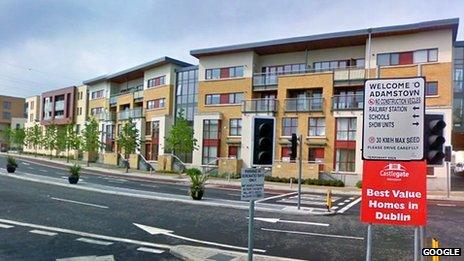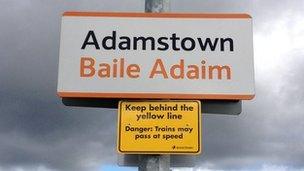Irish recession: Inside an 'empty' town
- Published

One of the legacies of Ireland's boom years was the proliferation of new housing stock, much of it now sitting empty. Adamstown near Dublin symbolises the ambition, and subsequent puncturing, of the Irish economic dream.
It is just before 10:00 on a weekday morning but I am the only passenger to get off the train. The gleaming new railway station has five platforms, even though for most of the day there is only an hourly service.
The automatic ticket gates are wide open - as I pass, a lone attendant nods from the depths of his kiosk.
At the bottom of the steps is a plaque cast in metal with golden lettering.
"Adamstown Station - officially opened on 16th April 2007 by An Taoiseach Bertie Ahern."
April 2007 - one of the last optimistic months. A time when hope was still in the air, just before the so called "Celtic Tiger" economy got sick, and then fell fatally ill.
Adamstown epitomises the ambitions of those years of growth that started in the mid 1990s. Dublin was getting rich quick.
Multinational companies were recruiting, new businesses opening, served by economic migrants from Eastern Europe and returning Irish hoping to claim their piece of the Celtic dream.
The city needed new homes for its burgeoning population, and so in 1998 plans were laid for a grand new town. Ten thousand dwellings to start, 25,000 citizens.
The location chosen could hardly have been better, a green field site alongside a mainline railway, less than 15 minutes from Dublin and near the trunk road which links the capital with the country's north-west.
In 2006, at the height of Ireland's housing boom, the first properties went on sale.
In scenes that seemed common at the time, potential purchasers queued around the clock - 330 houses sold in the first two days alone, more than half to first-time buyers.
"Adamstown - it's a whole new ball game", proclaims the slogan on the glossy brochure I am handed by the immaculately groomed estate agent minding the show house.
"How's business?" I ask. "Slow," she admits. Today's price list has four-bedroom townhouses starting at €215,000 (£175,000). A similar property would have cost €500,000 (£405,000) before the collapse.
Outside the window, a security man watches me from his van, parked by the wooden hoardings surrounding the spot where the next phase of houses will be built.
"When will work start?" I continue. My friend does not seem sure at first, then her estate agent's bright confidence clicks in. "In the next few weeks I hope," she nods. "What's it like to live here?" "Quiet," she says. "Very quiet."
Currently just over 1,200 homes are occupied. Families with school-age children are well provided for.
There are two primary schools and a secondary level college. The rooms of the Giraffe creche are packed with younger children, but they are one of the few signs of life I see as I walk the town's streets.
Other than a postman, a pair of council workers mending a pavement and a solitary jogger, the place seems empty.
The silence is only broken by announcements from the station tannoy, blown across town on the breeze, telling non-existent passengers to step back from the platform edge as a fast train is approaching.
The place has the feel of an American suburb, rather than a bustling Irish town.
The first people who chose to live here were assured that their pioneering spirit would be rewarded.
There would be nearly 50 shops, nine restaurants and two public houses. To date a single convenience store, a hairdresser and a pizzeria are the only community facilities.

Four parks would provide residents with a green oasis - there were mock-ups of a grand library on a square with open air cafes, promises of an eight-screen cinema.
On a hoarding in front of one abandoned building site, five children in swimming goggles gaze out from a poster.
The fact there is no pool is covered in sober language in the Adamstown Annual report: "Planning permission was granted for a sports and leisure building in 2008. Construction of these facilities has not commenced to date."
And yet there is a sense of community here. There may not be a church, but there is a Gaelic Athletic Association (GAA) club. There are walking and cycling groups.
The proliferation of South Asian names in the line up of the Adamstown Cricket Club, and the provision of English lessons in one of the schools, reflect an increasingly multicultural Ireland.
Even though they represent little more than 10% of what was planned, the houses that have been built are pleasing, confident buildings, modern in style, but also nodding to Dublin's Georgian architectural heritage.
New towns across the world from Chandigarh in India, to Tsuen Wan in Hong Kong, to England's Milton Keynes, have all taken time to find an identity, to become loved by their citizens.
As I walk back to the station, past hopeful posters and empty cycle racks, I contemplate what the years ahead hold for Adamstown.
Like many aspects of Irish life at present, it is as if a pause button has been pressed. The place waits in an extended holding pattern, but the future is not completely without hope.
<bold>How to listen to From Our Own Correspondent</bold> <bold>:</bold>
<bold>BBC Radio 4: </bold>A 30-minute programme on Saturdays, 11:30 BST.
Second 30-minute programme on Thursdays, 11:00 BST (some weeks only).
<link> <caption>Listen online</caption> <url href="http://www.bbc.co.uk/programmes/b006qjlq" platform="highweb"/> </link> or <link> <caption>download the podcast</caption> <url href="http://www.bbc.co.uk/podcasts/series/fooc" platform="highweb"/> </link>
<bold>BBC World Service: </bold>
Hear daily 10-minute editions Monday to Friday, repeated through the day, also available to <link> <caption>listen online</caption> <url href="http://www.bbc.co.uk/programmes/p002vsng" platform="highweb"/> </link> .
Read more or <link> <caption>explore the archive</caption> <url href="http://news.bbc.co.uk/1/hi/programmes/from_our_own_correspondent/archive/default.stm" platform="highweb"/> </link> at the <link> <caption>programme website</caption> <url href="http://news.bbc.co.uk/1/hi/programmes/from_our_own_correspondent/default.stm" platform="highweb"/> </link> .